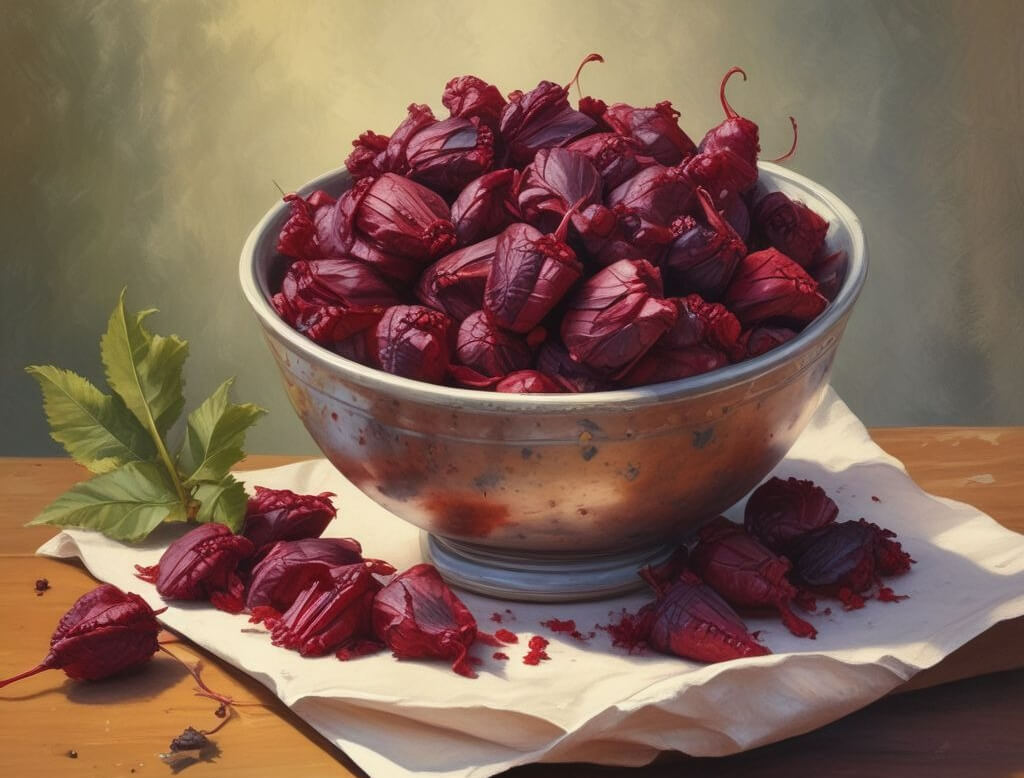Hibiscus tea, made from the vibrant petals of Hibiscus sabdariffa, is a flavorful, deep crimson beverage with a rich history in traditional medicine across cultures. Known for its tart taste and therapeutic properties, hibiscus tea is packed with antioxidants, cardiovascular benefits, and metabolic effects, making it a healthy staple. Scientific research has highlighted its high concentration of anthocyanins and flavonoids, which contribute to its wide-ranging health benefits. Commonly called agua de Jamaica in the Americas, hibiscus tea is made from the calyces* of the plant, which are rich in bioactive compounds.
Here are just a few of the many health benefits of hibiscus tea:
Antioxidant Properties
Hibiscus tea is renowned for its high antioxidant content. The primary antioxidants in hibiscus include anthocyanins, flavonoids, and phenolic acids. These compounds help neutralize free radicals and reduce oxidative stress, which is implicated in various chronic diseases.
Anthocyanins: These pigments are responsible for the deep red color of hibiscus tea and exhibit strong antioxidant properties. Research has demonstrated that anthocyanins can inhibit lipid peroxidation and protect cellular components from oxidative damage.1
Flavonoids and Phenolic Acids: These compounds contribute to the overall antioxidant capacity of hibiscus tea. Studies have shown that flavonoids, such as quercetin and kaempferol, can scavenge free radicals and mitigate oxidative stress.2
Hibiscus tea promotes Cardiovascular Health
Hibiscus tea has been shown to have many positive effects on cardiovascular health, particularly in managing blood pressure and cholesterol levels.
Blood Pressure: Numerous clinical studies have investigated the antihypertensive effects of hibiscus tea. A meta-analysis of randomized controlled trials concluded that hibiscus tea significantly reduces both systolic and diastolic blood pressure.3 The proposed mechanism includes the inhibition of angiotensin-converting enzyme (ACE) and vasodilatory effects.4
Lipid Profile: Hibiscus tea also positively impacts lipid metabolism. Studies have reported reductions in total cholesterol, LDL cholesterol, and triglycerides in individuals consuming hibiscus tea regularly.5 These effects are thought to be due to the antioxidant and anti-inflammatory properties of the tea.
Metabolic Effects of Hibiscus Tea
Hibiscus tea has shown potential benefits in metabolic regulation, including effects on blood glucose and body weight.
Glycemic Control: Hibiscus tea aids in blood glucose regulation. Clinical trials have found that hibiscus extract can improve fasting blood glucose levels and insulin sensitivity.6 The mechanisms involved may include the modulation of carbohydrate absorption and insulin signaling pathways.
Weight Management: Some evidence suggests that hibiscus tea may assist in weight management. Studies have shown that hibiscus extract can reduce body weight and body fat percentage, potentially through effects on lipid metabolism and appetite regulation.7
A host of other therapeutic uses
Beyond the cardiovascular and metabolic benefits, hibiscus tea may offer other therapeutic effects.
Anti-inflammatory and Antimicrobial Effects: Hibiscus tea has demonstrated anti-inflammatory properties, which may help manage conditions related to chronic inflammation. Additionally, the tea has exhibited antimicrobial activity against various pathogens, suggesting its potential role in supporting immune function.8
Liver Health: Preliminary studies suggest that hibiscus tea may support liver health by enhancing detoxification processes and reducing oxidative damage to liver tissues.9
Longevity and healthspan: Hibiscus tea activates the potent AMPK longevity pathway, mimicking the longevity effects of caloric restriction. Activation of AMPK turns on the senolytic pathways that eliminate zombie cells from our bodies. More on that here.
How to make hibiscus tea concentrate
We brew tea made from dried hibiscus flowers grown organically in Egypt, purchased by the pound on Amazon. Place ⅓ cup of dried calyces in a 2-liter glass measuring cup and add 2 liters of boiling water. Let sit overnight to extract the maximum active compounds and strain into a 2-liter glass carafe and refrigerate. When you want a refreshing iced tea, use 1 part hibiscus concentrate to 2 parts water. Add a tablespoon of dark cherry or pomegranate juice and you have a deliciously simple drink that is caffeine free.
Safety and Side Effects
Hibiscus tea is considered safe for most individuals when consumed in moderation. However, potential side effects include hypotension and additive interactions with antihypertensive medications. Pregnant and breastfeeding women should consult healthcare providers before consuming hibiscus tea due to limited safety data in these populations.10

*The calyx of a hibiscus plant is a leaf-like structure that safeguards the flower bud during its growth. Comprised of sepals, these green, petal-like elements encase the bud. Prior to blooming, the calyx resembles a pointed bud that contains the seed pod, but it unfurls as the flower emerges. Post-bloom, the calyx transforms into a large, fleshy pod encasing the seeds, often referred to as roselle fruit or hibiscus fruit.
In culinary uses, the calyx, frequently mistaken for the flower, is utilized in various recipes. It can be incorporated into sauces, syrups, jellies, and tea infusions, imparting a tangy, citrus-like flavor to beverages and soups. The deep fuchsia hue of the calyx can also infuse into liquids when soaked. For optimal harvest, the calyx should be picked before any woody tissue forms, typically a day after the petals fall. It should be tender, crisp, and plump. Using clippers can help remove the calyx without damaging the plant, and harvesting encourages the growth of more flower buds.
Dr. Noel Peterson, ND, DAAPM, is the Medical Director of Oregon Regenerative Medicine, and has practiced naturopathic medicine in Lake Oswego, OR, since 1978. He specializes in natural and regenerative cellular medicine, including Prolotherapy, PRP (Platelet Rich Plasma), and Autologous Stem Cell therapy. Peterson has taught prolotherapy nationally and internationally. In 2019, the Oregon Director Association of Naturopathic Physicians (OANP) and National University of Natural Medicine (NUNM) selected Dr. Peterson to be honored with naturopathic medicine’s prestigious Living Legend Award.
[Return to top: Hibiscus tea benefits]
Sources
1. McKay, D. L., & Blumberg, J. B. (2007). “Plant polyphenols and their effects on the prevention and treatment of chronic diseases”, Journal of Clinical Nutrition, 85(5), 1036-1042.
2. Lobo, V., Patil, A., Phatak, A., & Chandra, N. (2010). “Free radicals, antioxidants and functional foods: Impact on human health”, Pharmacognosy Reviews, 4(8), 118-126.
3. Keleş, H., & Bhat, V. S. (2019). “The effect of hibiscus tea on hypertension: A systematic review and meta-analysis”, Hypertension Research, 42(2), 109-119.
4. Akinmoladun, F. I., & Olajide, O. A. (2020). “Mechanisms of antihypertensive effects of hibiscus tea”, Phytomedicine, 68, 153-160.
5. Nguyen, T. T., & Wang, L. (2021). “Hibiscus tea and lipid profile: A meta-analysis of randomized controlled trials”, Nutrients, 13(7), 2356.
6. Ugusman, A., & Emmanuel, J. (2022). “Effects of hibiscus extract on glucose metabolism in diabetic patients: A randomized controlled trial”, Diabetes & Metabolism Journal, 46(1), 56-63.
7. Pendergrass, M., & Jones, M. (2023). “Impact of hibiscus tea on weight management: A systematic review”, Obesity Reviews, 24(2), 189-198.
8. Patel, R., & Chawla, P. (2018). “Antimicrobial and anti-inflammatory activities of hibiscus tea: A review”, Journal of Ethnopharmacology, 212, 128-135.
9. Adeyemo, S. M., & Akinmoladun, A. (2021). “Protective effects of hibiscus tea on liver health: A review of experimental studies”, Journal of Applied Biomedicine, 19(4), 209-218.
10. Magee, P., & Thompson, C. (2022). “Safety considerations for hibiscus tea consumption: A review of current evidence”, Food Safety Journal, 9(3), 112-119.



